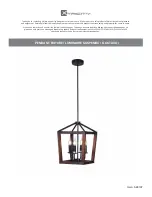
999-995-137.10_REV. B
8
K-5208 Drain Cleaning Machine
Greater distances from the drain access increases
the risk of the cable twisting or kinking. If the machine
cannot be placed with the cable outlet within 2' (0.6 m)
of the drain access, extend the drain access with sim-
ilar sized pipe and fittings
(see Figure 5
). Improper
cable support can allow the cable to kink and twist and
can damage the cable or injure the operator.
8. Unlock the clutch lever handle
(Figure 4)
.
Figure 5 – Example of Extending Drain to within 2' (0.6m)
of Machine Cable Outlet
9. Attach the rear guide hose to the machine
(Figure 6)
by sliding the bracket over the posts. Do not use ma-
chine without rear guide hose attached. The rear
guide hose improves cleanliness and reduces the
risk of cable whipping and entanglement. A lanyard
mounted pin is supplied to retain the guide hose to the
machine.
Figure 6 – Rear Guide Hose Attachment
10. Fully remove a section of cable from the carrier and in-
sert female end of the cable into cable outlet of the
machine
(Figure 7)
. Push the cable through machine
and guide hose until approximately one foot (0.3 m) re-
mains out the front of the machine. Disconnect the
cable section from the cable sections still in the carrier.
Do not use the drain cleaner to rotate cable in carrier,
this may cause striking or crushing injuries.
Cable sections can be removed from the cable carrier
one at a time as used, or all at once, as the situation
requires. If using the drum style cable carrier, placing
the cable carrier near the drain opening and the ma-
chine cable outlet allows convenient access for load-
ing and unloading of cable sections.
See Figure 7.
Figure 7 – Inserting Cable Into Front Of Machine
11. Select proper tool for the conditions. If the nature of the
obstruction is unknown, it is good practice to use a
straight auger to explore the obstruction and retrieve
a piece of the obstruction for inspection.
Once the nature of the obstruction is known, an ap-
propriate tool can be selected for the application. A
good rule of thumb is to start by running the smallest
available tool through the blockage to allow the
backed-up water to start flowing and carry away the
debris and cuttings as the drain is cleaned. Once
the drain is open and flowing, other tools appropriate
for the blockage can be used. Generally, the largest
tool used should be no bigger than the inside diame-
ter of the drain minus one inch.
Proper tool selection depends on the specific cir-
cumstances of each job and is left to the user’s judge-
ment. A variety of other tools are available and are
listed in the Optional Equipment section of this man-
ual. Other information on tools can be found in the
RIDGID Catalog.
12. Securely install tool on the end of the cable
(see
Figure 8)
. If the connection is not secure, the cutting
tool may fall off in use. As the cutting tool is installed
make sure that the spring-loaded plunger in coupling
on the end of cable moves freely to retain the tool. If
the pin sticks in the retracted position, the cutting
tool may fall off in use.
13. Insert tool and cable end at least 1' (0.3 m) into drain.
2' (0.6 m)
Max
Pin

































